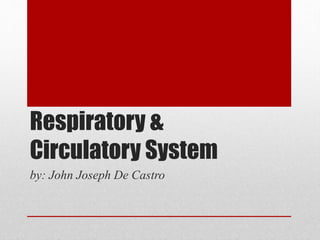
Respiratory & Circulatory System.pptx
- 1. Respiratory & Circulatory System by: John Joseph De Castro
- 2. • Respiratory system is made up of the organs in the body that help us to breathe. Just remember that the word respiration is linked to breathing. Circulatory system is responsible for distributing materials throughout the body. Take note that circulation means transportation or movement in circles. Both systems are essentially meant for each other. The common purpose could not be attained without the other system.
- 3. • The parts of the respiratory system that are in charge of supplying oxygen are the nose, nasal passageways, windpipe, lungs, and diaphragm. In the nose and nasal passages, the entering air is made warm, damp, and clean of unknown particles. Next, the air moves down through the trachea, bronchi, bronchioles, and alveoli. Trachea is the empty tube that serves as passageway of air into the lungs. Bronchi are the two branching tubes that connect the trachea to the lungs. Bronchioles are the hairlike tubes that connect to the alveoli. Alveoli are the airsacs that allow gas exchange in the lungs.
- 5. KEY CONCEPTS • When you breathe in, or inhale, the diaphragm muscle contracts. Inhaling moves the diaphragm down and expands the chest cavity. Simultaneously, the ribs move up and increase the size of the chest cavity. There is now more space and less air inside the lungs. Air pushes in from the outside where there is a higher air pressure. It pushes into the lungs where there is a lower air pressure. When you breathe out, or exhale, the diaphragm muscle relaxes. The diaphragm and ribs return to their original place. The chest cavity returns to its size. There is now less space and greater air inside the lungs. It pushes the air outside where there is lower air pressure.
- 6. KEY CONCEPTS • Air first enters your lungs and then into the left of your heart. It is then driven by your heart into bloodstream, all the way through your body. The heart pumps blood, which transports essential nutrients, oxygen, and other chemicals to every cell in your body. Once it reaches the cells, oxygen processes the nutrients to release energy. Carbon dioxide is given off during this process. The blood delivers carbon dioxide into the right portion of your heart, from which it is pumped to the lungs. Carbon dioxide leaves your body through the lungs when you exhale.
- 7. • The circulatory system is the life support structure that nourishes your cells with nutrients from the food you eat and oxygen from the air you breathe. It can be compared to a complex arrangement of highways, avenues and lanes connecting all the cells together into a neighborhood. Sequentially, the community of cells sustains the body to stay alive. Another name for the circulatory system is the cardiovascular system. • The circulatory system functions with other body systems to deliver different materials in the body. It circulates vital elements such as oxygen and nutrients. At the same time, it also transports wastes away from the body.
- 8. • The following are the three major parts of the circulatory system, with their roles: 1. Heart – pumps the blood throughout the body 2. Blood vessel – carries the blood throughout the body • Arteries - carry oxygenated blood away from the heart to the cells, tissues and organs of the body • Veins - carry deoxygenated blood to the heart • Capillaries - the smallest blood vessels in the body, connecting the smallest arteries to the smallest veins – the actual site where gases and nutrients are exchanged 3. Blood – carries the materials throughout the body
- 11. • The Human Heart • The heart is a hollow muscle which is just as big as your fist. It has four chambers with specific tasks to do: two ventricles and two atria. The atria are the receiving chambers of the heart, accepting blood from the body (right atrium) and from the lungs (left atrium). The ventricles are the pumping chambers, moving blood to the lungs (right ventricle) and into the body (left ventricle).
- 12. • The heart has two pumps. Each pump has two chambers, the upper and lower chambers. The upper chamber is the atrium that receives blood coming in from the veins. The lower chamber is the ventricle that forces the blood out into the arteries. There is a valve between each atrium and ventricle to prevent the blood from flowing backwards. The valves are like one-way doors that keep the blood moving in only one direction. Valves control movement of blood into the heart chambers and out to the aorta and the pulmonary artery.
- 14. • All of the muscle tissues of the heart do not contract at the same time. Different parts of the heart contract at different times. When the top portion contracts, the bottom part relaxes. When the bottom contracts, the top relaxes. When a chamber contracts, it becomes smaller and the blood inside gets squeezed or pumped out.